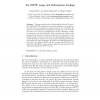Free Online Productivity Tools
i2Speak
i2Symbol
i2OCR
iTex2Img
iWeb2Print
iWeb2Shot
i2Type
iPdf2Split
iPdf2Merge
i2Bopomofo
i2Arabic
i2Style
i2Image
i2PDF
iLatex2Rtf
Sci2ools
CMS
2010
2010
Tor HTTP Usage and Information Leakage
This paper analyzes the web browsing behaviour of Tor users. By collecting HTTP requests we show which websites are of interest to Tor users and we determined an upper bound on how vulnerable Tor users are to sophisticated de-anonymization attacks: up to 78 % of the Tor users do not use Tor as suggested by the Tor community, namely to browse the web with TorButton. They could thus fall victim to deanonymization attacks by merely browsing the web. Around 1% of the requests could be used by an adversary for exploit piggybacking on vulnerable file formats. Another 7 % of all requests were generated by social networking sites which leak plenty of sensitive and identifying information. Due to the design of HTTP and Tor, we argue that HTTPS is currently the only effective countermeasure against de-anonymization and information leakage for HTTP over Tor.
| Added | 29 Oct 2010 |
| Updated | 29 Oct 2010 |
| Type | Conference |
| Year | 2010 |
| Where | CMS |
| Authors | Marcus Huber, Martin Mulazzani, Edgar Weippl |
Comments (0)

